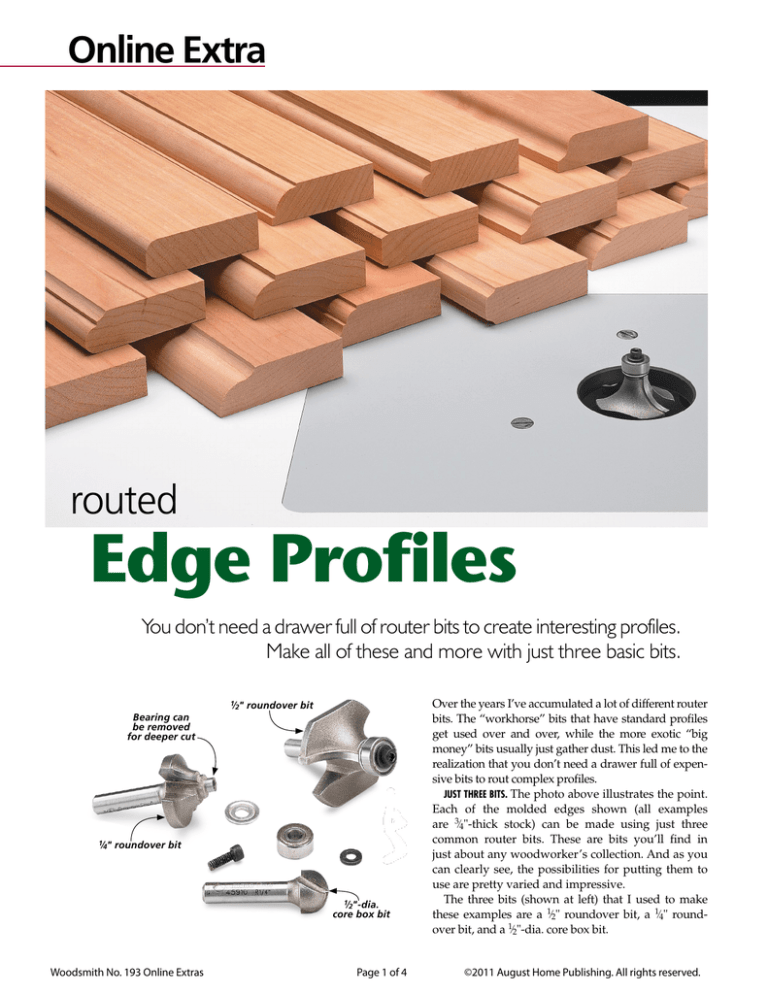
Online Extra
routed
Edge Profiles
You don’t need a drawer full of router bits to create interesting profiles.
Make all of these and more with just three basic bits.
!/2" roundover bit
Bearing can
be removed
for deeper cut
!/4" roundover bit
!/2"-dia.
core box bit
Woodsmith No. 193 Online Extras
Page 1 of 4
Over the years I’ve accumulated a lot of different router
bits. The “workhorse” bits that have standard profiles
get used over and over, while the more exotic “big
money” bits usually just gather dust. This led me to the
realization that you don’t need a drawer full of expensive bits to rout complex profiles.
Just Three Bits. The photo above illustrates the point.
Each of the molded edges shown (all examples
are 3⁄4"-thick stock) can be made using just three
common router bits. These are bits you’ll find in
just about any woodworker’s collection. And as you
can clearly see, the possibilities for putting them to
use are pretty varied and impressive.
The three bits (shown at left) that I used to make
these examples are a 1⁄2" roundover bit, a 1⁄4" roundover bit, and a 1⁄2"-dia. core box bit.
©2011 August Home Publishing. All rights reserved.
One bit, several cuts. Here and on the next two pages,
you’ll see how to make seventeen of my favorite profiles. There’s really no great secret to the process. First,
I try to avoid getting stuck on the idea that a single
router bit can only make one type of cut. The truth is
that many types of bits can produce a variety of shapes
depending on how you put them to use. To make
some of the profiles shown in the main photo on the
previous page, I used different parts of the bit or
changed the depth or height of the cut. For example, a
core box bit (or cove bit) can be used to create a wide,
shallow cove or a deep hollow.
Multiple Bits. Some of the simple profiles you see
on the first page were made using only a single bit.
But to create the more complex shapes, you’ll
need to use a combination of bits. For instance, a
1⁄ " roundover along with an accurately cut 1⁄ " cove
2
4
creates a large reverse ogee.
Accurate cuts. One of the keys to success is to make
the cuts carefully and accurately. Two or three (or
more) light cuts will often yield smoother results
than one deep cut. This is more important
than doing the job quickly. And finally, a little
fine sanding is often needed to “blend” multiple cuts
into one smooth, seamless profile.
How-To: 7 Easy Profiles
One Setup
1
2
3
Shop Tip: Design it
As you can see, the layout tools I used to design
these profiles are pretty basic. A section of 1⁄2"-dia.
dowel is a great template for a 1⁄4" round-over or
a 1⁄4" cove (1⁄2"-dia. core box bit). And a 1"-dia.
dowel is my 1⁄2" roundover bit. Chances are, if
you can draw a profile on paper, you can find a
way to make it with a few common router bits.
4
5
Woodsmith No. 193 Online Extras
Page 2 of 4
©2011 August Home Publishing. All rights reserved.
6
Two Setups
7
8
9
10
11
Woodsmith No. 193 Online Extras
Page 3 of 4
©2011 August Home Publishing. All rights reserved.
12
13
14
Three Setups
#/4
!/2"-dia. core
box bit
#/16
15
16
17
Woodsmith No. 193 Online Extras
Page 4 of 4
©2011 August Home Publishing. All rights reserved.



